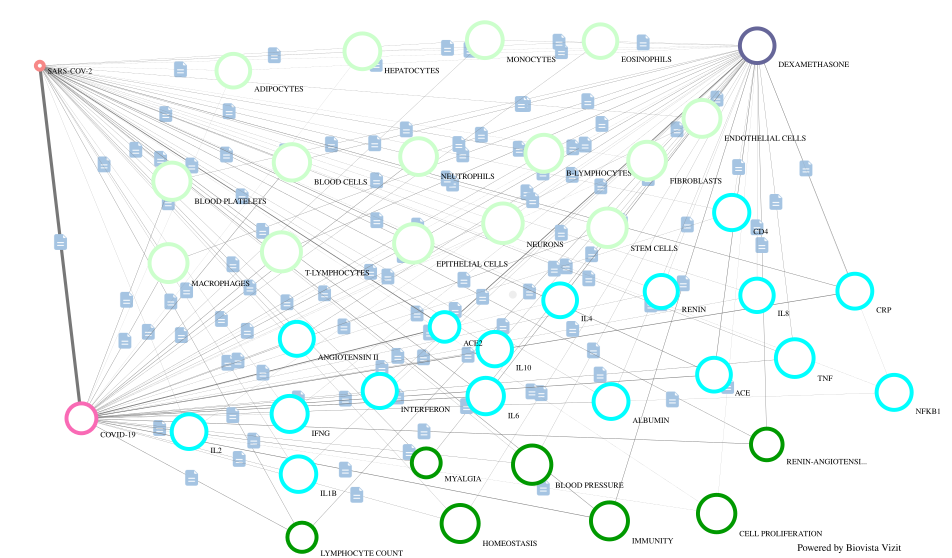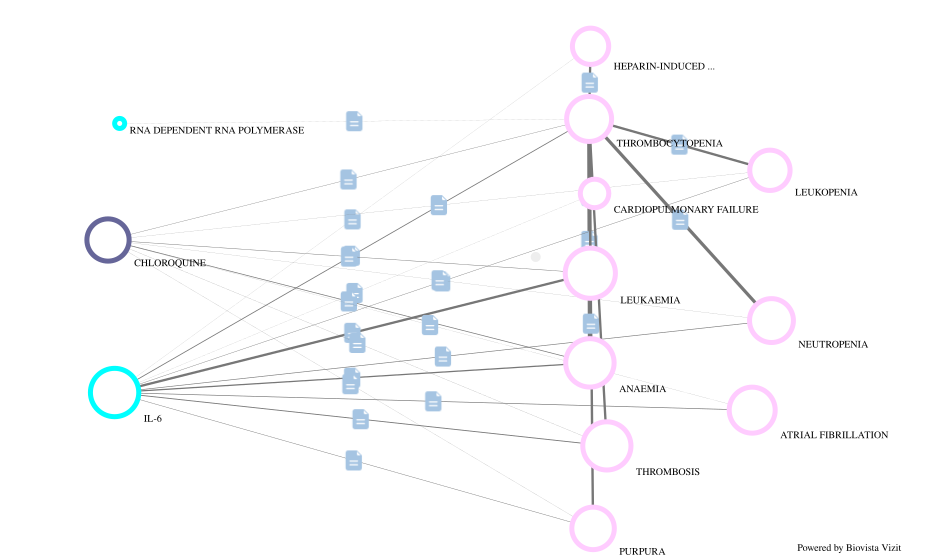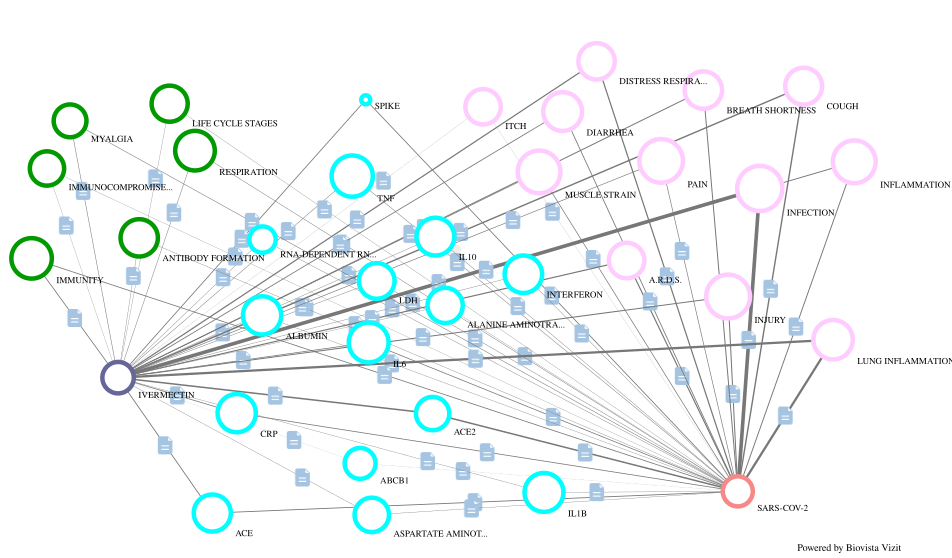
WELCOME to Covid-19 Commons.
Covid-19 Commons is a global resource aiming to:
- Summarize all current efforts relating to the treatment of Covid-19. We share here Biovista Vizit graphs that represent the main biological entities that are central to each research hypothesis we identify from public resources. We will keep updating this list with new hypotheses, as we are made aware of them.
- Support collaboration in the search for an understanding of the biology of SARS-CoV-2 and the development of novel treatments for Covid-19. The Biovista Vizit graphs listed are actionable. Clicking on these graphs will take you straight into the Biovista Vizit environment. Feel free to use each graph as a starting point to assess and expand on the reported findings, or to create your own hypotheses. If you wish to share your hypothesis, send us an email with your Biovista Vizit graph and we will add it to the Covid-19 Commons.
Covid-19 Commons organizes current research work in 2 sections:
- Section A: lists graphs that explore hypotheses on the biology of SARS-CoV-2.
- Section B: lists graphs that explore hypotheses on possible treatments for Covid-19.
In both sections one graph is created for each hypothesis, and is annotated with purported mechanism of action (MoA) information as this is reported in the .
Section A: SARS-CoV-2 Biology
Lists graphs that explore hypotheses on the biology of SARS-CoV-2.
Graph A1: ACE2, TMPRSS2, Acute Lung Injury, ARDS, and Lung Fibrosis

Title: ACE2, TMPRSS2, Acute Lung Injury, ARDS, and Lung Fibrosis.
Reference: Biovista white paper
Contact: info@biovista.com
Context: The graph visualizes the relationships between genes ACE2 and TMPRSS2 and specific manifestations of COVID-19, such as Acute Lung Injury, ARDS and Lung Fibrosis through a network of specific biological entities such as Cell Types, Pathways and Anatomical Locations that are likely implicated in the pathogenesis of these disease symptoms.
Graph A2: SARS-CoV-2 and Blood Vessel Dysfunction

Title: Genes that are possibly implicated in SARS-CoV-2-mediated blood vessel disease.
Reference: Biovista white paper
Contact: info@biovista.com
Context: In addition to respiratory symptoms, novel findings have shown vascular complications in a series of patients with COVID-19, suggesting that COVID-19 is more to a respiratory infection caused by SARS-CoV-2. This graph illustrates some of the possible mechanisms (genes) by which these effects of SARS-CoV-2 may be mediated.
Section B: Covid-19 novel treatment hypotheses
Lists graphs that explore hypotheses on possible treatments for Covid-19.
Graph B1: Dexamethasone

Title: Dexamethasone mechanism of action analysis in the treatment of SARS-COV-2 induced infections.
Context: Dexamethasone is a widely-used and safe steroid that has been studied in the context of treating viral respiratory disorders, and is THE FIRST drug that has been shown to reduce mortality of patients with severe COVID-19.
Graph B2: Lopinavir/Ritonavir

Title: Lopinavir/Ritonavir mechanism of action analysis in COVID-19.
Context: Lopinavir/Ritonavir (Kaletra) is a combination of the antivirals Lopinavir and Ritonavir, that were originally designed to inhibit HIV from replicating by binding to the protease. Similarly, it has been postulated that the drug could also bind to the protease of SARS-CoV-2. The drug is currently being tested for the treatment of COVID-19.
Graph B3: Adverse Events of Chloroquine remdesivir, hydroxychloroquine, and interleukin (IL)-6 inhibitors

Title: Adverse Event considerations for repositioning remdesivir, hydroxychloroquine, chloroquine, and interleukin (IL)-6 inhibitors in COVID-19 patients.
Context: Patients with COVID-19 often also face cardiovascular challenges and associated comorbidities. Understanding how repositioned drugs to treat COVID-19 may impact the cardiovascular health of patients is important.
Live Graph Detail: Targets of the drugs are included (e.g. RNA dependent RNA polymerase, target of remdesivir, IL-7, target of IL-6 inhibitors).
Graph B4: Implication of the RAS system in COVID-19

Title: Targeting the RAS system against COVID-19.
Reference: Biovista white paper
Contact: info@biovista.com
Context: There is growing amount of evidence to suggest the use of pharmaceuticals that target the Renin-Angiotensin System (e.g. angiotensin 1-7, ARBs and ACE inhibitors) may be beneficial in the treatment of COVID-19. This graph shows the interconnections among these classes of drugs, and SARS-CoV-2 via key genes implicated in this pathway. mediated.
Graph B5: Vitamin D

Title: Administration of vitamin D could help fight COVID-19.
Reference: Biovista white paper
Contact: info@biovista.com
Context: Vitamin D supplementation has been shown to protect against SARS-COV-2 infection, and could be particularly helpful for patients that exhibit shortage of vitamin D (e.g. seniors, immunocompromised patients) leading to complications such as cardiovascular comorbidities. This graph explains the mechanism of action of vitamin D in COVID-19 via key genes implicated.
Graph B6: Azithromycin

Title: Mechanistic analysis of Azithromycin.
Context: Azithromycin is being tested in COVID-19 patients. Although it is a potent antibiotic, in the COVID-19 setting, it likely acts as an anti-inflammatory agent. Its exact MoA in the disease, however, remains to be elucidated.
Graph B7: Tocilizumab

Title: Mechanistic analysis of Tocilizumab.
Context: Tocilizumab (Acterma) is an immunosuppressive drug (IL-6 inhibitor) mainly used in the treatment of rheumatoid arthritis and is currently being tested in COVID-19 patients.
Graph B8: Ivermectin

Title: Mechanistic analysis of Ivermectin.
Context: Ivermectin is an anti-parasitic agent that has shown promise against the virus in vitro. Its potential mechanism of action (MoA) in COVID-19, is poorly understood.
Graph B9: Acalabrutinib

Title: Mechanistic analysis of Acalabrutinib (Calquence).
Context: Acalabrutinib is an anti-cancer medicine (tyrosine kinase inhibitor) showing promise in early studies. Its potential mechanism of action (MoA) is poorly understood. If understood better, more anti-cancer drugs can be rationalized against COVID-19. MoA elements include genes, and pathways that may explain the MoA of the drug in particularly ameliorating cytokine storm-related features in COVID-19.
Graph B10: Combination IFB-a2b chlorpheniramine, ibuprofen

Title: Mechanistic analysis of combination IFB-a2b chlorpheniramine, ibuprofen.
Context: Chlorphenamine is a known antihistamine used to treat the symptoms of allergic conditions such as allergic rhinitis, whereas Ibuprofen is a potent nonsteroidal anti-inflammatory drug (NSAID). Combination of Chlorpheniramine and ibuprofen combination have long been postulated to treat common cold and its symptoms. Role and efficacy in the COVID-19 remains to be elucidated.
Graph B11: Eculizumab

Title: Mechanisms by which Eculizumab (Soliris) may benefit COVID-19 patients with respiratory distress syndrome.
Context: Eculizumab is a biologic therapy, a complement C5 inhibitor, and has recently shown promise in COVID-19. The graph provides an important step towards elucidating the MoA of this drug in COVID-19.
Graph B12: Amantadine

Title: Pathways and cell types related to Amantadine’s MoA in COVID-19.
Context: Amantadine is an anti-viral drug which is also used in Parkinson’s disease. The drug has been shown to reduce viral load in the context of the influenza virus, and in the COVID-19 setting, it may be able to decrease the viral load in SARS-CoV-2 positive patients.
Graph B13: Atorvastatin

Title: Mechanistic analysis of Atorvastatin.
Context: Repositioning of Atorvastatin for the treatment of COVID-19. Statins such as Atorvastatin are potent cholesterol-lowering dugs that are tested against COVID-19. Statins could be proven beneficial particularly against SARS-CoV-2-induced cardiovascular manifestations.

